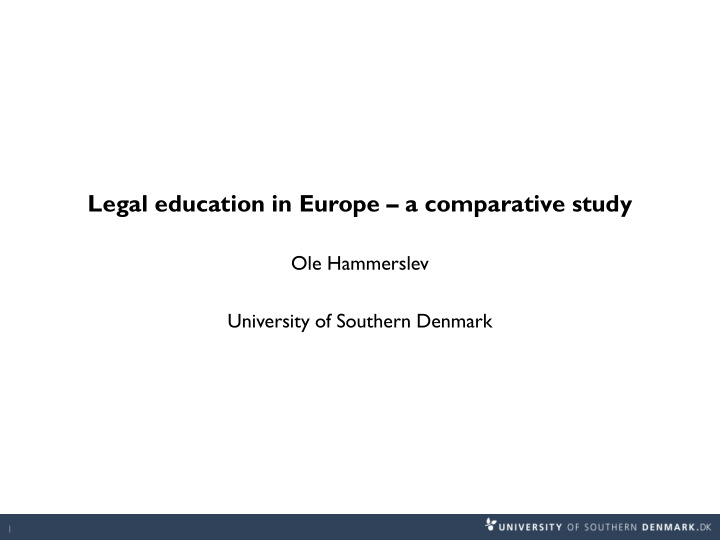



Legal education in Europe – a comparative study Ole Hammerslev University of Southern Denmark 1
Outline EU-efforts to develop common legal training in the EU Key findings of the Menu for Justice-project Challenges for legal education in a new global setting 2
The aims of EU in the area of judicial training In 2011 the EU Commission strengthened once again its focus on harmonization of European law within the EU Member States when it stressed the need for training of judges and legal practitioners in union law ‘to empower citizens and businesses to stand up for their rights and to ensure the effectiveness of the Single Market.’ The Commission combines the development of the union law with effective implementation of the transnational legal order which guarantees legal predictability, security and uniform interpretation of the law throughout Europe 3
The aims of EU in the area of judicial training Difficult to deepen the single market with the existing acquis communautaire already comprising 1521 directives and 976 regulations related to the various single market policy areas Member states not too willing to implement EU law Judges are using EU law differently Therefore: A key issue in order to have a single market, which works, is to pay more attention to law enforcement 4
The aims of EU in the area of judicial training National judges play a key role in interpreting and applying EU law next to national law. The Commission, in partnership with Member States, should support training programmes and structures to ensure that national judges and legal professionals have a solid knowledge of the Single Market rules they are most often required to apply A study done by ERA (Academy of European Law) in 2011 showed that 51% of judges and prosecutors had never participated in judicial training on union or another member state’s law, while 74% was of the opinion that the number of cases involving union law had increased 5
The aims of EU in the area of judicial training Against this background the EU Commission has as its objective to enable half of the legal practitioners in the EU to participate in European judicial training activities by 2020 6
The aims of EU in the area of judicial training Legal practitioners in the 27 EU Member States (EU COM (211) 551 p. 4. Professional judges 79.100 Prosecutors 35.032 Lawyers, solicitors, barristers 868.615 Court staff 351.220 Bailiffs 29.060 Notaries 38.269 Total 1.401.296 7
Background of Menu for Justice Menu for Justice (funded by Lifelong Learning Programme) 2009-2013: European project with 52 European partners from 27 countries Legal and judicial training in Europe 8
Menu for Justice Questions: How are we actually educating judges and legal practitioners in Europe? How should judges and magistrates be trained in law and legal matters and how can they develop new skills and competences to effectively face the challenges of a common judicial space Methods: questionnaires, conference presentations from stake holders 9
A Map of Legal Education in Europe : <https://legaleducationineurope.crowdmap.com/> 10
Uploadede country reports for the map Austria 7 Lithuania 3 Belgium 13 Luxembourg 1 Denmark 4 Malta 2 Estonia 3 The Netherlands 11 Finland 4 Poland 21 France 56 Portugal 26 Germany 41 Romania 43 Greece 3 Slovakia 6 Hungary 9 Slovenia 3 Iceland 4 Spain 69 Ireland 8 Sweden 6 Italy 70 United Kingdom 89 Latvia 12 Total 514 11
European law degrees The composition of law degrees Bologna-model (Germany, Hungary and Norway + Italy) Autonomy (Germany, Hungary) Formal/legal structures Study boards, accreditation, recruitment panels Informal 12
European law degrees Law students’ competence profile/pedagogical methods Theoretical vs. practical skills Non-dogmatic topics (sociology, accountancy, public administration, organisation of courts, communication etc. EU-law, human rights, international law – independent topics not included in national topics Moot-court, Legal clinics – develop the practical skills of law students 13
European law degrees E-learning/assessments (K.U. Leuven – JURIMATIC, SDU etc.) (Phil Race & Sally Brown) Distance learning jurafjern.sam.sdu.dk Adobe connect New form of competences 14
Challenges for future legal education Outsourcing/off shoring of legal services (Susskind) IT (Susskind) Stratification/divergence – a law student is not just a law student Example exchange programs See Börjesson & Broady ”The Social Profile of Swedish Law Students. National Divisions and Transnational Strategies” in Retfærd. Nordic Journal of Law and Justice , no. 3/114: http://www.retfaerd.org/old_issues/vol-29-2006 Globalisation of educational institutions Distance learning, collaboration between universities Branches in different parts of the world 15
Challenges for future legal education Feminisation of legal education Exams (Schultz) Pink & red files (Mossman, Sommerlad) Etc. 16
Conclusion Enforcing and ‘settling’ of EU law in the EU member states European legal educational institutions adapt to new and diverse challenges 17
Recommend
More recommend